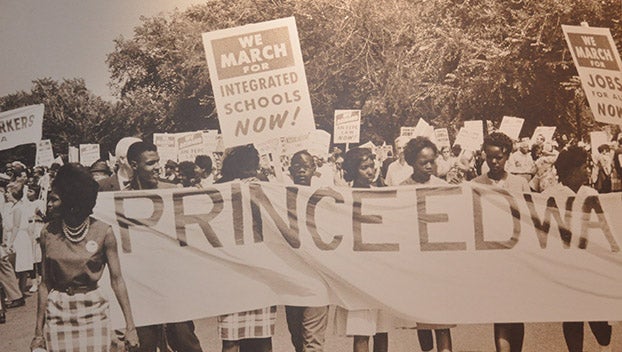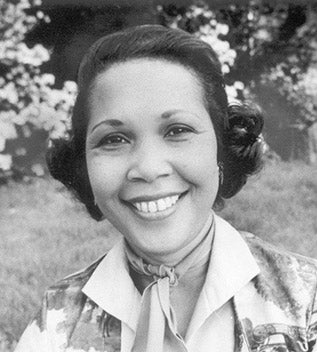Honoring Barbara Rose Johns : New project will tell her story
Published 5:45 pm Friday, August 19, 2022

- This photo that hangs inside the Robert Russa Moton Museum shows members of the community marching in protest.
|
Getting your Trinity Audio player ready...
|
FARMVILLE – Many people know the Supreme Court’s Brown v. The Board of Education ruling declared segregation in public schools was unconstitutional. But far fewer have heard of Barbara Rose Johns, the 16-year-old Prince Edward County resident who started that push for education equality. Thanks to one local group, that’s about to change.
Years before the Montgomery bus boycotts and Dr. Martin Luther King’s “I Have A Dream” speech, Johns organized a two-week-long strike in 1951, working with fellow students at Robert Russa Moton High School.
The dedication and courage of Johns and her classmates is what inspired National Endowment for the Humanities(NEH)-supported documentarian and scholar Richard Wormser to create the Barbara Johns project, made possible by a grant from Virginia Humanities.
What is the project about?
The project includes an interactive website on Johns’ story and focuses mainly on Farmville: An American Story, a film written and co-produced by Wormser. The 24 minute film uses original footage from Farmville in the 1950s and features testimonies of former Moton students, PTA members and Johns’ sister to show an authentic experience of what life was like before, during and after the strike led by Johns.
“What motivated me to want to see some change take place here for the student body, it’s the frustration, it’s anger, a feeling of dejection,” said Johns in a 1987 CBS interview featured in the film. “There wasn’t any fear, I just felt this is your moment, seize it.”
Wormser and his team gather input from teachers to know what their needs are in the classroom to try and design the site in a way that it will be useful to their students. The project, he said, is aimed at providing a more constructive approach to teaching race relations to students in Virginia, as well as showing the individual courage which transcends race and age.
“It gives a positive outlook in terms of resistance against injustice, which can apply to anything or anybody, not just simply black and white,” Wormser said.” It also deals with the important history of Virginia in terms of the segregated schools and their desegregation.”

Barbara Rose Johns
More about Moton School
Johns’ courage in standing up for the rights of her fellow students is even more commendable considering it was during the Jim Crow Era, a time where segregation was mandated by law. This discrimination became all too apparent in Moton High School as the student population grew and there was not enough room for students.
Built to hold 180 students, by the 1940s there were 450 crammed inside. County officials, however, refused to pay for permanent expansion. Instead, they built temporary buildings to handle the extra kids. Dubbed the “tar-paper shacks”, they were covered in roofing material.
Testimonies from former students in Farmville: An American Story recount experiences of having classes on school buses and in poorly-made tar paper shacks which would constantly leak and lacked sufficient heating. Moton athletes had no locker rooms and had to wear old uniforms passed down from White schools, oftentimes ripped or unusable.
In the film, Moton High School graduate Edna Allen Bledsoe recounted seeing a White high school close by and was astounded by how gorgeous the building looked.
“I couldn’t believe this is what they had for a building,” Bledsoe said. “While I’m sitting here with an umbrella on a rainy day so the ink wouldn’t run on my paper.”
Barbara Rose Johns and classmates strike
Motivated by this frustration, Johns and her classmates started the strike while receiving threats that their parents would lose their jobs and go to jail, as well as cross burnings in their yards.
Three weeks after the strike, NAACP lawyers came to Farmville, and with the support of the local Black community, took the case to the Supreme Court where eventually segregation would be declared unconstitutional in 1954.
Although a constitutional victory had been won, the Commonwealth of Virginia imposed a policy of “massive resistance”. When the strategy failed, Prince Edward County closed its public schools for five years and school desegregation was delayed until the 1960s.
“In 1964, public schools were finally integrated as a result of the struggle, dedication and persistence at the Robert Moton High School in the spring of 1951,” said the narrator of Wormser’s film.
Virginia Humanities and the Moton Museum
David Bearinger, the now-retired director of the Virginia Humanities Grants Program, had also worked closely with Wormser for this project. He stated in an email that the story of Barbara Rose Johns, her fellow students and their supporters remains unfinished.
“The events are complicated; their impact is complicated,” Bearinger stated. “The prospect of creating an online resource in which students, now and in the future, can explore this story for themselves speaks to the heart of Virginia Humanities, our mission, and why we do the work we do.
The Moton Museum, which also features an exhibit on Johns’ story, is working with Wormser on the project. The permanent exhibition, “The Moton School Story, Children of Courage,” opened in April 2013 with the support of two NEH grants totalling $390,000
Justin Reid, director of community initiatives for Virginia Humanities, formerly worked in a leadership position at the museum and was instrumental in the work of cultivating it into a stellar national Civil Rights museum, stated Carolyn R. Cades, senior associate director of the Grats Program at Virginia Humanities, in an email.
It is one of the only two Virginia stops in the U.S. Civil Rights trail, “with invaluable support and input from the knowledgeable and dedicated alumnae and staff of the Robert Russa Moton School and the Museum which grew from it,” Cades stated.
The Virginia Foundation for the Humanities has supported multiple projects concerning the Moton Strike, Cades stated. This includes a grant to Virginia Tech to conduct oral histories for a memoir by Barbara Johns and an episode about the Farmville walkout and subsequent school closings on the radio program With Good Reason. That episode has been used as a teaching tool and won a Gabriel Award in 2012 from the Catholic Academy of Communication Professionals
Christopher Bonastia wrote the book Southern Stalemate: Five Years without Public Education in Prince Edward County, Virginia in 2012 published by the University of Chicago Press, with an NEH fellowship.
Looking forward
The project is currently just getting started and is expected to be complete in a couple of years. Wormser said the design and testing will take around six to eight months and it needs additional funding through grants.
When the project is completed it will be available to museums and educational institutions.
“The result will inspire, inform, and encourage students, teachers, and anyone who uses the site,” Bearinger stated. “It’s hard to imagine a better example of how one determined individual, working alongside others, really can change the world.”
To learn more about Barbara Rose Johns and the Moton School strike, Wormser recommends visiting the Moton Museum’s “Moton School Story: Children of Courage” exhibition. You can also learn more at their website at motonmuseum.org.




